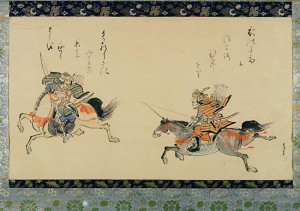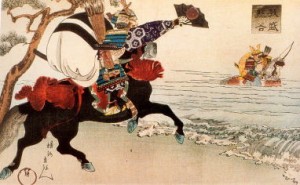A code of Samurai, Japanese chivalry (2) 2015/05/26
The beginning of a code of Samurai is unclear. However it is commonly understood the influencing event happened during the battle of Koromogawa (a battle between Imperial court and district powers) in 1057.
Minamoto Yoshiie, a leading general of a winning camp could not put an end to Abe Sadatou who was also a leading general of losing camp. They met in a battlefield and exchanged sophisticated songs in the field. Yoshiie was deeply moved by the calmness and courage of the loosing general and let him free from the field.
Yoshiie was praised for his gentle humanity and above is understood the first incident of Samurai’s mercy.
Another famous incident for Samurai’s mercy happened in 1185 at the battle of Ichinotani during famous long war between Minamoto and Taira (Genpei war).
Kumagaya Naozane, a strong general among winning Minamoto camp met a young small general, Taira Atsumori. Naozane wished to release Atsumori but finally had to kill him, because Atsumori would not leave the field and preferred to be killed rather than to be disgraced by running away in front of an enemy.
After the incident Naozane got weary of life and became a priest of Zen sect.
These stories were referred in popular books at that time such as 「Hogen monogatari」、「Heike monogatari」、「Genpei seisuiki」which were published in 13-14th century. Most Samurai read these books and learnt from these their senior’s behaviors.
In 1232, Kamakura shogunate issued ( Goseibaishikimoku) which clearly mentioned 51 articles for Samurai to keep strictly.









